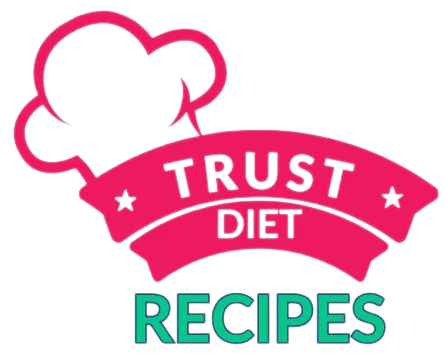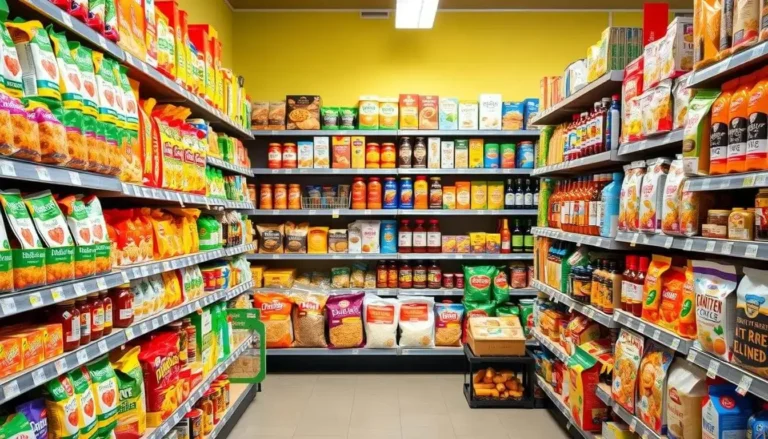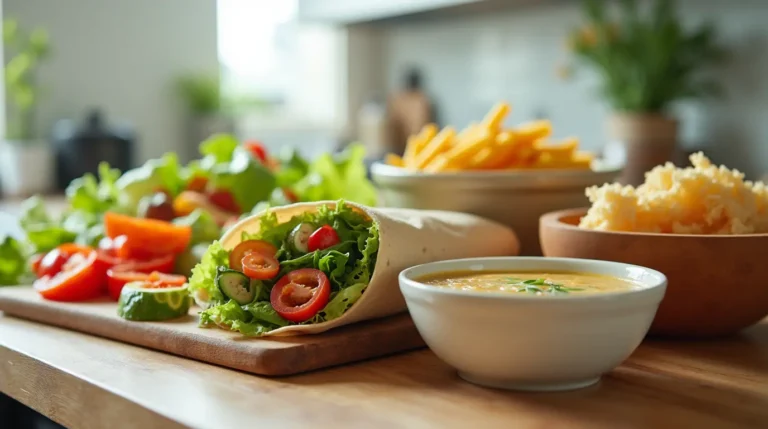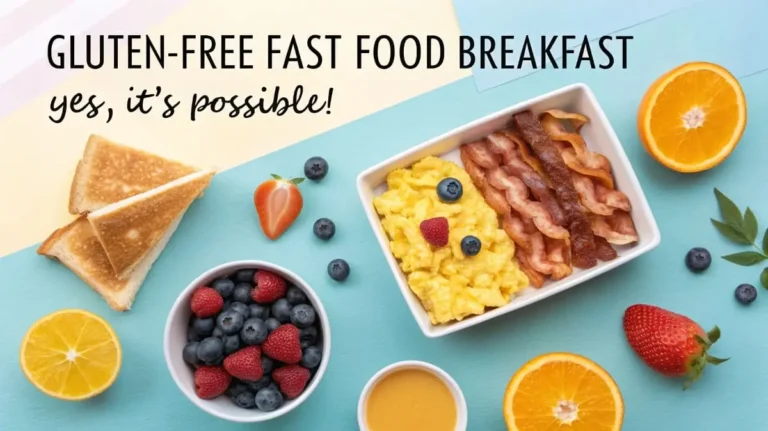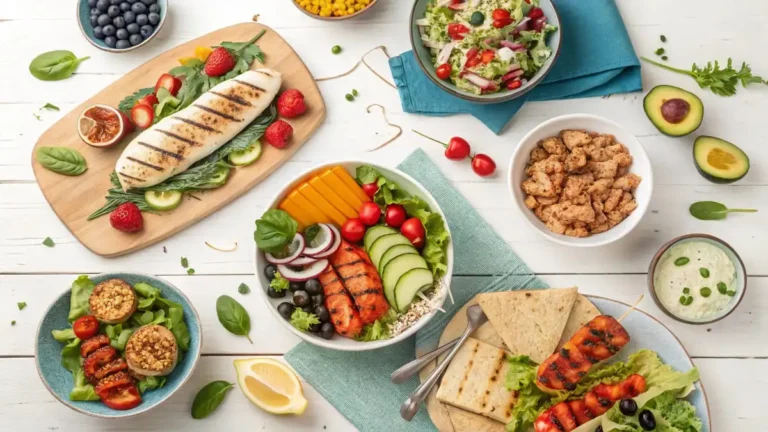Gluten-Free Grocery Store List: Your Essential Guide
Living with gluten intolerance can be tough. That’s why having a good gluten free shopping guide is key. It helps you make better choices at the grocery store.
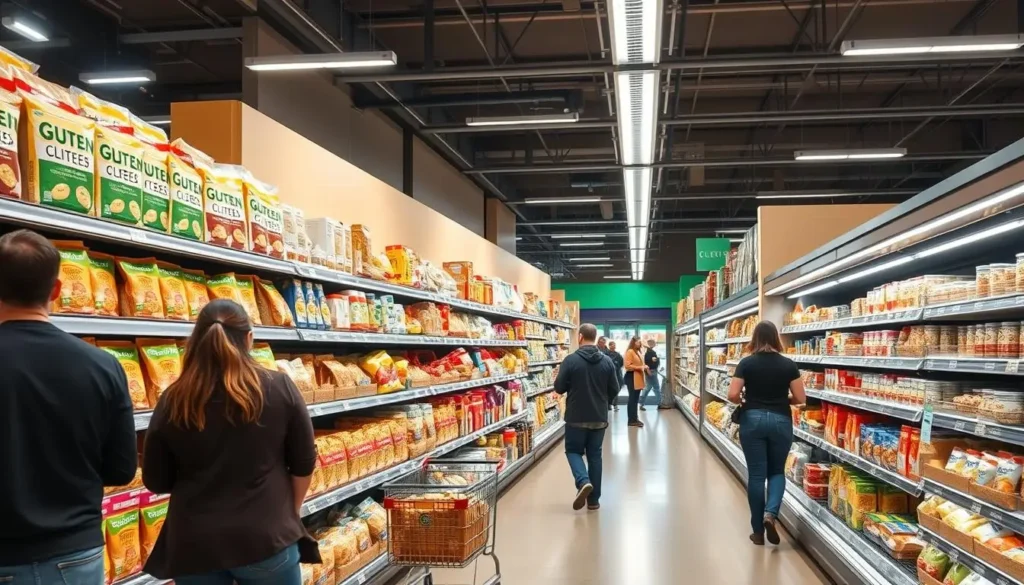
For those with gluten sensitivity, a detailed celiac friendly food list is vital. This guide will show you how to make a gluten-free grocery store list. It makes following your diet easier.
Table of Contents
Key Takeaways
- Understand the basics of a gluten-free diet
- Learn how to navigate grocery stores for gluten-free options
- Discover essential gluten-free products to include in your list
- Tips for maintaining a gluten-free lifestyle
- Resources for further learning and support
Why Going Gluten-Free Requires a Specialized Grocery List
Starting your gluten-free grocery shopping journey is all about knowing the basics. It’s important to understand gluten and how it affects health. A specialized grocery list is key, and knowing the basics of gluten is essential.
What is Gluten and Where is it Found?
Gluten is a protein in wheat, barley, and rye. It’s found in many foods like bread, pasta, and baked goods. It’s also in many processed foods, so reading labels is important for those avoiding gluten.
Health Conditions Requiring a Gluten-Free Diet
Some health issues, like celiac disease and gluten sensitivity, need a gluten-free diet. Celiac disease damages the small intestine when gluten is eaten. Gluten sensitivity causes similar symptoms but doesn’t damage the intestine as much. A special grocery list helps those with these conditions eat safely and healthily.
Navigating the Grocery Store with a Gluten-Free Mindset
To shop for groceries without gluten, knowing the store layout is key. You need to know which sections to focus on and which to be careful with.
Store Sections to Focus On
Some store sections are better for gluten-free shopping. The produce section is safe, as most fruits and veggies don’t have gluten. The meat and seafood areas are also good, as long as you pick fresh, unprocessed items.
Sections to Approach with Caution
Other sections need more care when shopping gluten-free. The bakery and bread aisle is full of gluten. Always check labels in the processed food sections to spot hidden gluten.
Dedicated Gluten-Free Aisles
Many stores have special gluten-free aisles now. These aisles have gluten-free versions of common products like pasta and bread. You can also find specialty items from best gluten free brands here, making shopping easier.
| Store Section | Gluten-Free Tips |
|---|---|
| Produce | Most fruits and vegetables are naturally gluten-free. |
| Meat and Seafood | Choose fresh, unprocessed products to avoid gluten. |
| Bakery and Bread | Avoid traditional bread and baked goods; look for gluten-free alternatives. |
Understanding the grocery store helps you make a healthy gluten free shopping list. This way, you can make smart choices about what you buy.
How to Read Food Labels for Hidden Gluten
When I’m shopping for gluten-free items, it’s key to know how to read labels. This helps me avoid hidden gluten. I always check the ingredients in my local grocery store for gluten.
Common Gluten-Containing Ingredients to Avoid
I always check the ingredient list for common gluten sources like wheat, barley, and rye. These can be hidden under different names, such as:
- Wheat (including spelt, kamut, and durum)
- Barley
- Rye
- Malt (usually made from barley)
- Brewer’s yeast
Understanding Certification Labels
Certification labels offer extra peace of mind when buying gluten-free products. Look for labels from trusted groups like the Gluten-Free Certification Organization (GFCO) or the Celiac Support Association (CSA). These labels show the product meets gluten-free standards.
Cross-Contamination Warnings
Even gluten-free products can get contaminated with gluten during processing. I watch for warnings like “processed in a facility that also processes wheat” or “made on shared equipment with gluten-containing products.” These warnings help me understand the risk of cross-contamination.
By paying attention to these details, I can shop with confidence. I make sure to choose products that are safe for my home.
My Complete Gluten-Free Grocery Store List for Beginners
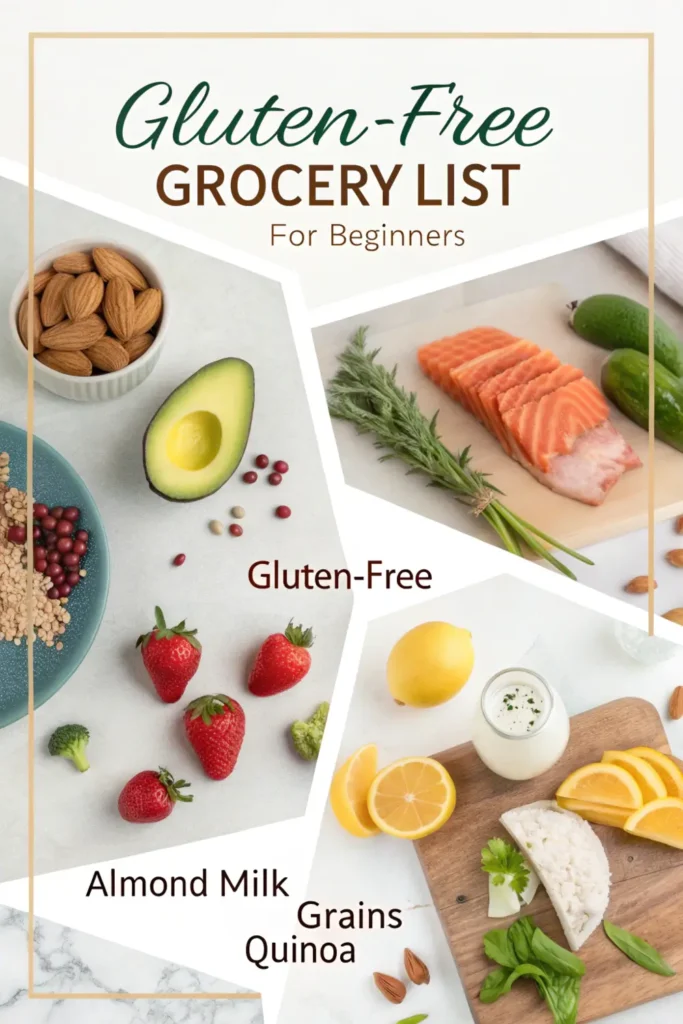
I’ve put together a gluten-free grocery store list for beginners. It covers many food types and meets different dietary needs. This list is here to help you start your gluten-free journey.
Printable Shopping List Overview
A printable shopping list is handy for beginners. It lets you mark off items as you buy them. This way, you won’t forget important gluten-free products. You can find printable lists online or make your own based on what you like to eat.
Digital Options for Your Shopping List
If you like digital tools, there are apps and online tools for managing your gluten-free list. These apps let you check off items, add new ones, and even share lists with others.
Organizing Your List by Store Layout
Organize your list by your local grocery store’s layout to shop more efficiently. This approach saves time and helps you not miss out on key items.
| Store Section | Gluten-Free Options |
|---|---|
| Produce | Fruits, Vegetables |
| Meat Department | Fresh Meat, Poultry, Seafood |
| Dairy | Milk, Cheese, Yogurt (check for gluten-free labeling) |
| Pantry | Gluten-free Grains, Canned Goods |
With a well-organized gluten-free grocery store list, you’ll find shopping easier. It helps you overcome the challenges of gluten-free shopping.
Gluten-Free Grains and Flours
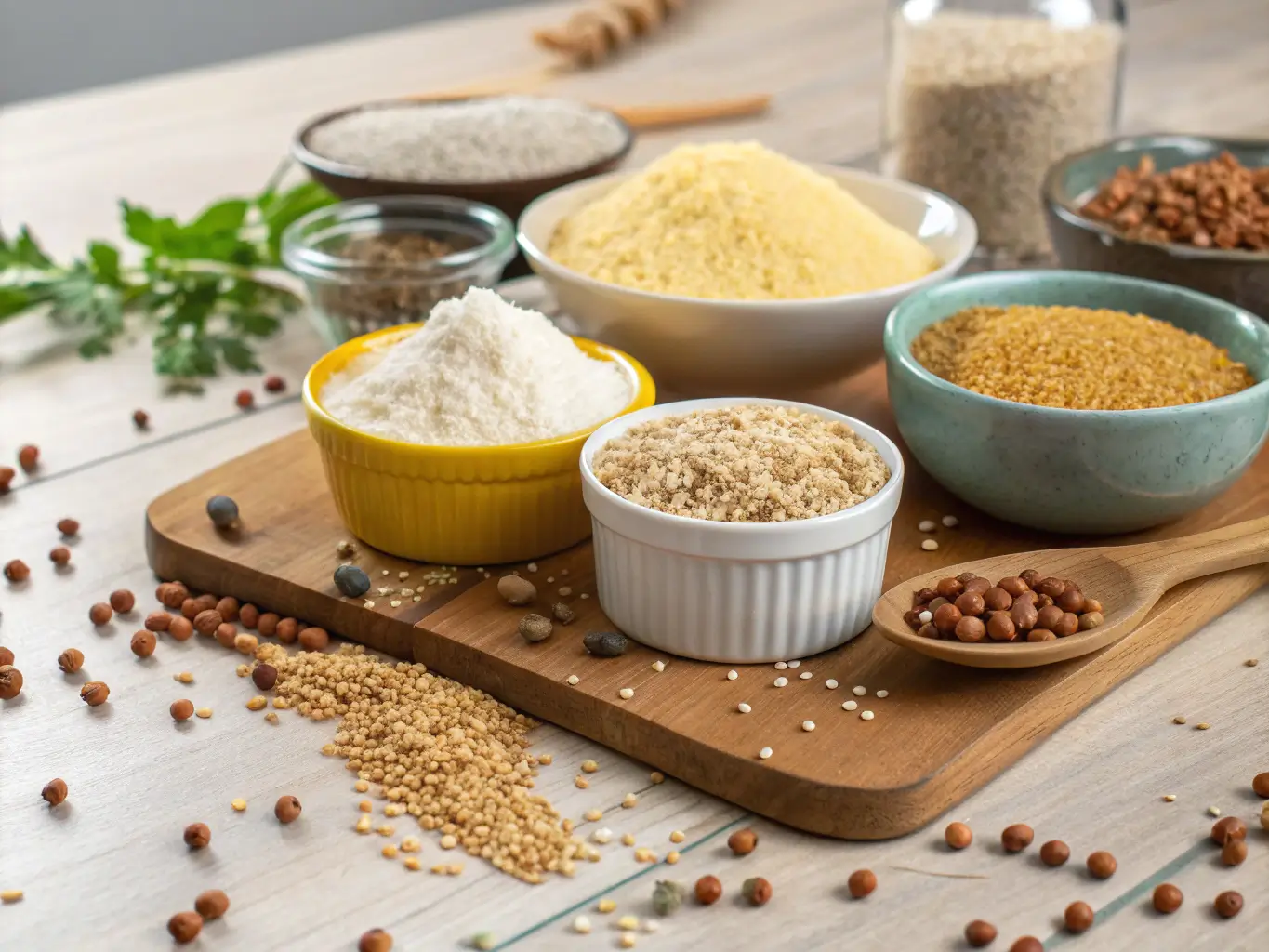
Exploring gluten-free baking shows how key it is to know about different grains and flours. With many choices, picking the right ones can feel daunting. I’ll share the safe whole grains and flour substitutes great for gluten-free baking.
Safe Whole Grains
Whole grains are vital for a healthy diet, and there are many gluten-free ones. My top picks include:
- Rice
- Quinoa
- Buckwheat
- Millet
These grains are not only gluten-free but also packed with nutrients and fiber. I enjoy adding them to meals for extra texture and nutrition.
Flour Alternatives for Baking
The right flour is essential for baking. Here are some top flour alternatives for gluten-free baking:
All-Purpose Flour Blends
All-purpose flour blends are a must-have in my gluten-free pantry. They mimic traditional wheat flour and work well in many recipes. Brands like Bob’s Red Mill and King Arthur are favorites.
Specialty Flours
There are also specialty flours that add unique flavors and textures. Some examples are:
- Almond flour
- Coconut flour
- Teff flour
These flours help make tasty and innovative gluten-free products. I love trying different mixes to find the best for my recipes.
Knowing about gluten-free grains and flours lets you make a variety of tasty and healthy products. Whether you’re experienced or new to gluten-free baking, I hope this guide helps your journey.
Fruits, Vegetables, and Produce Section
The produce section is full of naturally gluten-free foods. This makes it key for a healthy gluten-free diet. Fresh fruits and veggies are not only gluten-free but also packed with nutrients.
Naturally Gluten-Free Options
Most fresh produce is naturally gluten-free. You can find a variety of fruits like apples, bananas, and berries. Vegetables such as leafy greens, broccoli, and bell peppers are also gluten-free. Adding these to your diet ensures you get essential gluten-free groceries.
Pre-Packaged Produce to Check
Even though most produce is safe, some pre-packaged or processed items might have gluten. This is because of added ingredients. Always read the labels to check for gluten or gluten-containing additives.
| Produce Type | Gluten-Free Status | Precautions |
|---|---|---|
| Fresh Fruits/Veggies | Gluten-Free | None |
| Pre-Packaged Salads | Usually Gluten-Free | Check Dressings/Additives |
| Frozen Fruits/Veggies | Gluten-Free | Check for Added Ingredients |
Choosing whole, unprocessed foods helps you make a healthy gluten-free shopping list. This list supports your dietary needs.
Protein Sources: Meat, Fish, and Plant-Based Options
Finding the right protein sources is key for a gluten-free diet. Protein is essential for health, and there are many gluten-free choices.
Fresh Meat and Seafood
Fresh meat and seafood are naturally gluten-free. They are great protein sources. Always check for “gluten-free” labels to avoid gluten.
Some top gluten-free grocery items include fresh chicken, beef, pork, fish, and shellfish.
Processed Meats to Check
Many processed meats are gluten-free, but some may have hidden gluten. Always read labels for gluten. Look for best gluten-free brands of sausages and deli meats.
Plant-Based Protein Alternatives
Plant-based proteins are diverse and fit well in a gluten-free diet. You can find many options in a gluten-free products directory.
Tofu and Tempeh
Tofu and tempeh are great for protein and are naturally gluten-free. Always check ingredients and look for certifications to ensure they are gluten-free.
Legumes and Beans
Legumes and beans are rich in protein, fiber, and nutrients. They are a key part of many gluten-free diets. Use them in soups, salads, and more.
In conclusion, a gluten-free diet can include many protein sources. Choose fresh meats, seafood, and plant-based options for a balanced diet.
Dairy and Dairy Alternatives
Understanding dairy and dairy alternatives is key for a gluten-free diet. Many dairy products are naturally gluten-free. But, some may have gluten from added ingredients or cross-contamination.
Safe Dairy Products
Most dairy products are gluten-free, making them safe choices. These include:
- Milk
- Yogurt
- Butter
- Most types of cheese
But, always check labels for any gluten-containing added ingredients.
Non-Dairy Gluten-Free Options
For those who can’t have lactose or prefer non-dairy, there are gluten-free options:
- Almond milk
- Soy milk
- Coconut milk
- Rice milk
Make sure to verify ingredients and look for gluten-free certification.
Cheese Products to Verify
While most cheese is gluten-free, some processed cheese products may have gluten. Be careful with:
- Cheese sauces
- Cheese spreads
- Processed cheese slices
Always check labels and choose products with gluten-free certification.
Snacks, Crackers, and Convenience Foods
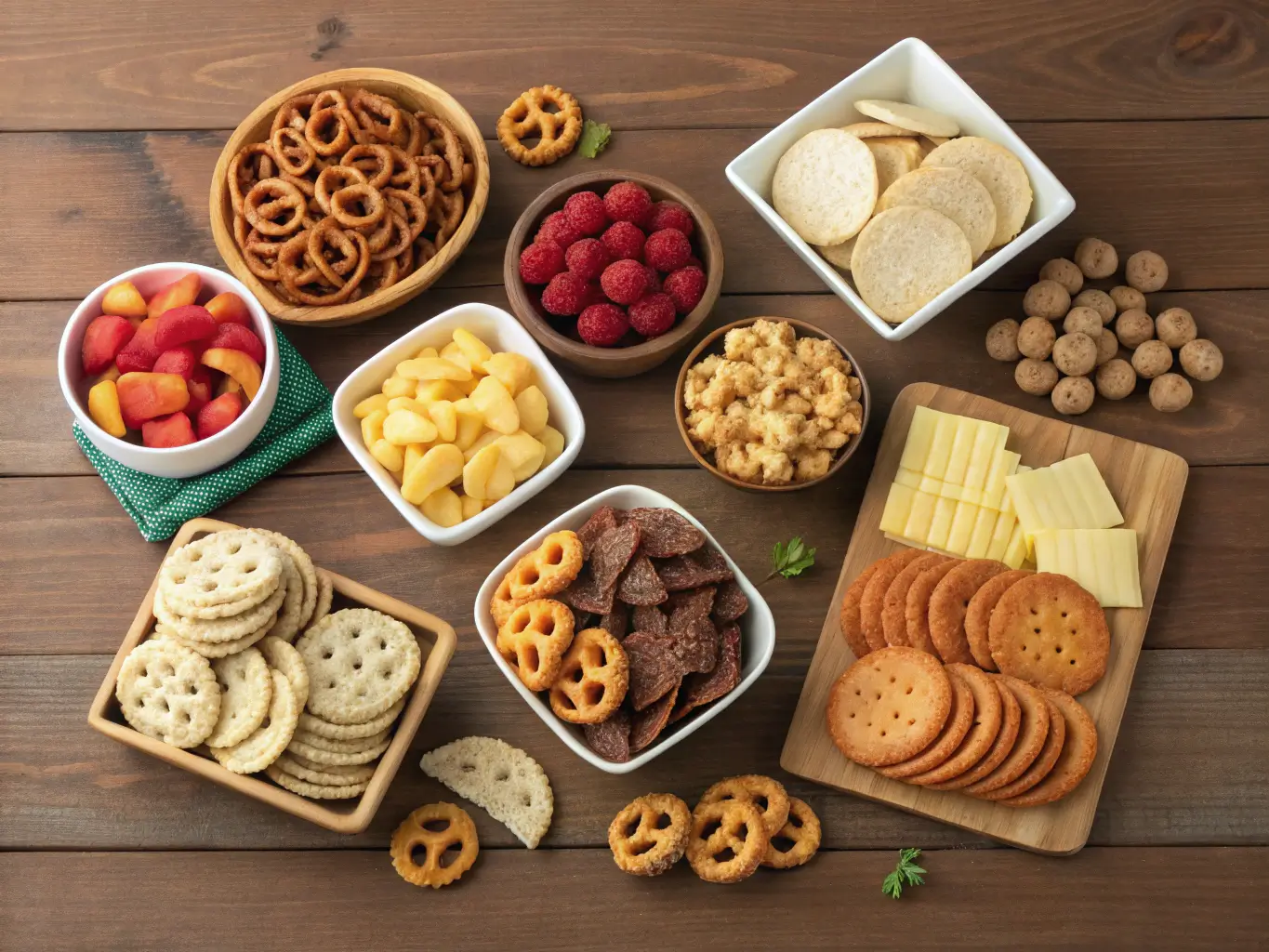
Gluten-free snacking has made huge strides. Many brands now offer tasty, high-quality options for any diet. You can find quick snacks or meal replacements easily.
Best Gluten-Free Chip Brands
Several brands are leading the way in gluten-free chips. Here are some of my top picks:
- Udi’s: They have delicious flavors and a crunchy texture.
- Terra: Provides a variety of flavors with wholesome ingredients.
- Jackson’s Honest: These chips are gluten-free and made with coconut oil, making them a healthier choice.
Crackers and Crisps
There are many gluten-free crackers and crisps to choose from:
- Mary’s Gone Crackers: They offer a range of flavors using organic ingredients.
- Blue Diamond: Their almond-based crackers are a tasty gluten-free option.
Granola and Energy Bars
Granola and energy bars are great for a quick snack or post-workout fuel. Here are some top picks:
- RXBAR: Known for their protein-rich ingredients and simple ingredients list.
- Kind Bar: They have a variety of gluten-free flavors with wholesome ingredients.
Kid-Friendly Options
Finding snacks for kids that are gluten-free and fun is key. Here are some great options:
- Enjoy Life Foods: They offer a range of kid-friendly snacks, including granola bars and chocolate chips.
- Glutino: Their gluten-free crackers and cookies are perfect for lunchboxes or after-school snacks.
Protein-Rich Choices
For those looking to increase their protein intake, there are many gluten-free snack options:
- Quest Nutrition: They offer protein-rich bars and chips that are gluten-free.
- Orgain: Their protein bars are made with organic ingredients and are gluten-free.
Condiments, Sauces, and Dressings
Condiments, sauces, and dressings can make or break a meal. But, many contain hidden gluten. It’s key for those on a gluten-free diet to watch out for these products.
Safe Options and Brands
Many brands offer gluten-free condiments and sauces. Some well-known ones include:
- Mustards from Annie’s Naturals and Maille
- Ketchups from Hunt’s and Annie’s Naturals
- Mayonnaise from Duke’s and Blue Plate
Always check the labels, as ingredients can change.
Hidden Gluten in Sauces
Many sauces have gluten from ingredients like wheat, barley, or rye. Some common ones include:
| Sauce Type | Potential Gluten Source |
|---|---|
| Teriyaki Sauce | Soy sauce (often contains wheat) |
| Barbecue Sauce | Malt vinegar or wheat-based thickeners |
| Salad Dressings | Wheat-based thickeners or barley malt |
As
“The key to a gluten-free diet is being informed and vigilant about the foods you consume.”
Making Your Own Gluten-Free Alternatives
One way to ensure your condiments and sauces are gluten-free is to make them yourself. Simple recipes can be found online. Many require just a few ingredients. For example, making your own mayonnaise or ketchup at home is straightforward. It lets you control what goes into your food.
By being mindful of the condiments and sauces you use and opting for gluten-free alternatives, you can enjoy a varied and flavorful diet without compromising your health.
Online Shopping Resources for Gluten-Free Products
Online shopping has made it easy to find gluten-free products at home. It’s great for those who need to avoid gluten. This section will look at the different online shopping options.
Dedicated Gluten-Free Websites
There are websites just for gluten-free products. Gluten-Free Mall and Udi’s have lots of gluten-free foods. They also have reviews and nutrition info.
Mainstream Retailers with Good Gluten-Free Selections
Big stores now sell gluten-free online. You can shop at Amazon, Walmart, and Thrive Market. They have good prices and fast shipping.
Subscription Services for Gluten-Free Foods
Subscription services are popular for gluten-free shoppers. Gluten-Free Box and Monthly Gluten-Free Box send gluten-free products to you. It’s a good way to try new things.
| Resource | Type | Notable Features |
|---|---|---|
| Gluten-Free Mall | Dedicated Gluten-Free Website | Wide selection, product reviews |
| Amazon | Mainstream Retailer | Competitive pricing, fast shipping |
| Gluten-Free Box | Subscription Service | Curated monthly deliveries |
Conclusion: Simplifying Your Gluten-Free Shopping Experience
Living gluten-free means you need to plan your shopping carefully. Knowing how to shop and what to look for on labels makes it easier. This way, you can enjoy a simpler shopping trip.
Having a good gluten-free grocery list is key. It should have gluten-free grains, fresh fruits and veggies, and proteins. Choosing whole foods and avoiding processed ones helps you eat well.
Now, you can make your own gluten-free shopping list with confidence. Organize it by the store’s layout. Also, consider online shopping and subscription services for more convenience.
With this knowledge, you can make your gluten-free shopping easier. Enjoy a healthier, more balanced lifestyle.
Don’t forget to check out our other resources for more special diet topic inspiration:
- 7-Day Keto Meal Plan for Beginners
- 7-Day Keto Meal Plan for Weight Loss
- 7-Day Keto Meal Plan on a Budget
- Save Time & Money: Simple Weekly Meal Plans You’ll Love
- Easy Keto Meals on a Budget: Your Ultimate Guide
- Easy Keto Meals: How to Start (Simple 7-Day Plan)
FAQ
What is a gluten-free grocery store list, and why do I need one?
A gluten-free grocery list is a collection of products without gluten. It helps you shop for food if you have celiac disease or gluten intolerance. It’s also useful if you choose to eat gluten-free.
How do I identify gluten-free products when shopping?
To find gluten-free products, look for labels like the Gluten-Free Certification Organization (GFCO) or the Celiac Support Association (CSA). Also, check the ingredient list for wheat, barley, and rye.
What are some common gluten-containing ingredients to avoid?
Avoid wheat, barley, rye, triticale, and sometimes oats because of cross-contamination. Also, watch out for hidden gluten in modified food starch, malt, and brewer’s yeast.
Can I shop for gluten-free products online?
Yes, you can buy gluten-free products online. Look for dedicated gluten-free websites, mainstream retailers with gluten-free options, and subscription services focused on gluten-free foods.
How do I read food labels to avoid hidden gluten?
To avoid hidden gluten, check the ingredient list for wheat, barley, and rye. Look for certification labels and be cautious of cross-contamination warnings. Also, be careful with ingredients that have unclear names.
What are some safe whole grains and flours for gluten-free baking?
Safe whole grains for baking include rice, quinoa, corn, and gluten-free oats. For flours, use almond flour, coconut flour, or gluten-free all-purpose flour blends made from rice, potato, or tapioca.
Are all dairy products gluten-free?
Most dairy products are gluten-free. But, some may have gluten from added ingredients or cross-contamination. Always check the labels and look for certification if you’re unsure.
Can I find gluten-free snack options?
Yes, there are many gluten-free snack options. Look for chips, crackers, granola, and energy bars from brands that specialize in gluten-free products. Always check the labels to ensure they meet your dietary needs.
How can I make my own gluten-free condiments and sauces?
To make your own gluten-free condiments and sauces, use gluten-free ingredients and be careful of cross-contamination. Many recipes online can guide you in making gluten-free alternatives to common condiments and sauces.
Are there any benefits to using a gluten-free grocery store list?
Using a gluten-free grocery list can make shopping easier. It ensures you buy gluten-free products and helps plan meals and snacks. This makes sticking to your gluten-free diet simpler.
